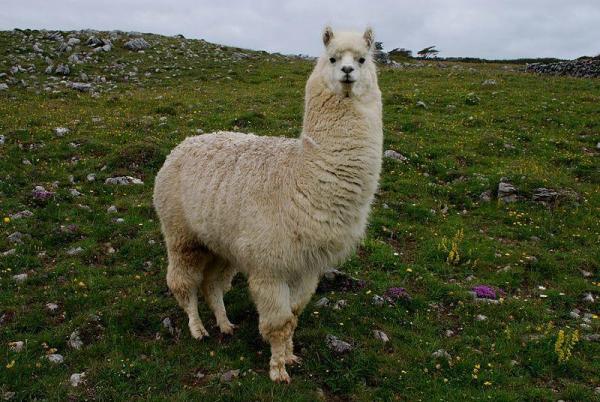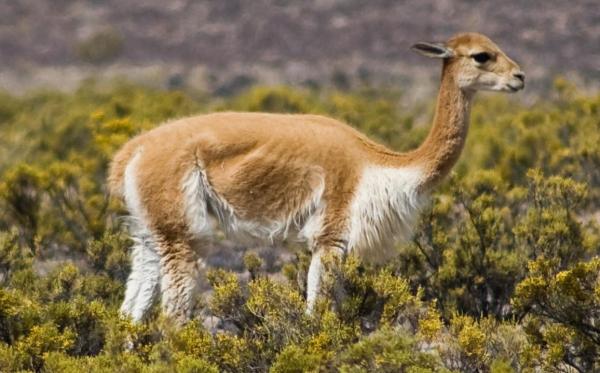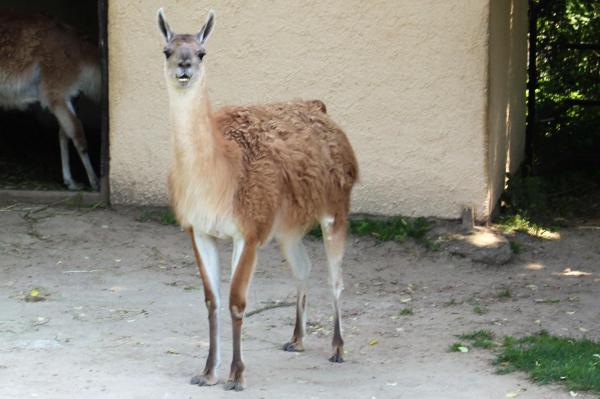
The llama and alpaca are both animals native the Andes Mountains. Both are very important cultural, historical and practical animals for the countries in this region. Their similarities in physical features and behavior show their close relation to each other. Despite such similarities and the fact they are from the same camelid family of mammals, they are not the same animal. While we can clarify what is the difference between a llama and alpaca, it is important to know that the true origins of both animals are difficult to determine. The reason for this is due to a lack of records in the place of origin and the interbreeding of animals which has occurred for many generations.
In this AnimalWised article we look at the llama vs alpaca, providing the key features of distinction so you can know which is which. We also provide information on vicuñas and guanacos, similar animals which are also sometimes confused with llamas and alpacas.
Alpaca vs llama - what are the similarities?
In addition to the physical similarities between them, there are other reasons it is easy to confuse llamas and alpacas. Firstly, they belong to the same taxonomic family Camelidae. This grouping also contains camels, dromedaries, vicuñas and guanacos. They are all ruminant artiodactyl mammals. They are ruminants because they ferment their food as part of their digestion and artiodactyl because they are even-toed ungulates.
Due to the physical similarities between all these animals, it can be possible to become easily confused. However, some are more easily confused than others. For example, camels and alpacas are fairly easy to distinguish. When it comes to alpacas vs llamas, the differences are much more subtle. To help us better know the difference between the alpaca and llama, let's consider their similarities.
Similarities between llamas and alpacas
Some common aspects that can cause us to confuse llama and alpaca are:
- Common habitat
- Both herbivorous
- Live in packs
- Have a docile temperament
- Spit when they are angry
- Physical appearance
- Soft fur
However, to really understand the difference between the llama and alpaca, we need to look closer at South American camelids.
South American camelids
According to a study published in the Chilean Journal of Natural History[1], there are four species of South American camelids. Two have been domesticated while the other two remain wild in the majority. They are:
- Guanaco (Lama guanicoe)
- Llama (Lama glama)
- Vicuña (Vicugna vicugna)
- Alpaca (Vicugna pacos)
As you will see, despite the fact it is llamas and alpacas which are so often confused with each other, there are significant differences. In fact, the llama has more in common with the guanaco and the alpaca with the vicuña.
Difference between llama and alpaca
The main difference between llamas and alpacas is the fact they are a different species, despite being taxonomically linked. There is some controversy among academics concerning the origin of both animals. As we have already explained, the hybridization rate of animals in this area has made studying them difficult. On a chromosomal level, llamas are more similar to guanacos and alpacas more similar to vicuñas.
Alpaca vs llama
Without having to look at their DNA, there are evident morphological differences between the llama and alpaca which can help us tell the difference between them:
- Size: an alpaca is visibly smaller than a llama. The same goes for weight as llamas are heavier than alpacas.
- Neck: we need to keep in mind that llamas have a longer neck than alpacas. Their height can exceed the size of an adult human.
- Ears: while llamas have long, pointed ears, alpacas have smaller rounded ears.
- Snout: llamas have a longer and more prominent snout than alpacas.
- Fur: the wool of the llama is rougher in texture.
- Personality: alpacas are more shy around humans, while llamas are known to be outgoing and even ‘daring’.
If you are wanting to know the difference between other animals which look similar to each other, you may enjoying reading our article on the differences between deer, elk, moose and reindeer.

Alpaca (Vicugna pacos)
It is estimated that the domestication of the alpaca began 6,000 or 7,000 years ago in the Peruvian Andes. Today, they can be found in Chile, Andean Bolivia and Peru. It is in the latter of these countries where the largest population of alpacas live. Here are some characteristics of the alpaca:
- They have been domesticated.
- They are smaller than llamas.
- Their fur can have 22 shades of colors that go from white to black (also brown and gray).
- They have long and soft fur.
An alpaca is visibly smaller than the llama. They measure between 1.2 m (3.9’) and 1.5 m (4.9’), and can weigh up to 90 kg. Unlike the llama, the alpaca cannot be used as a pack animal (i.e. transporting goods on their back). However, due to its quality, the wool of an alpaca is highly sought after. It is considered more valuable than the wool of a llama and its sale greatly boosts the local economies where they live.
As in the case of llama, alpacas are also known to spit to defend themselves. This id despite the fact they are docile animals. The reason why alpacas spit is generally as a form of either defence or competition. For example, if two alpacas are competing for food, they may spit at each other to show dominance.
Although alpaca and lamas are relatively plentiful, there are many animals in South America which are not. You can find out more by reading our article on

Llama (Lama glama)
One of the easiest ways to differentiate between the llama and alpaca is due to the fact llamas are the largest camelid in South America. They are known to weigh up to 150 kg. Bolivia is currently the country with the largest concentration of llamas, but they can also be found in Argentina, Chile, Peru and Ecuador. Distinguishing characteristics of the llama include:
- Being the largest camelid in South America.
- Measuring up to 1.8 m and weigh up to 150 kg.
- They have been domesticated.
- Long woolly fur.
- The color of its wool varies from white to dark brown.
Studies estimate that at least 6,000 years ago the llama was already a domesticated animal in the Andes. They were used by the Inca peoples for the transport of cargo and in wool production. They were very important in the local economy and were even used to accompany the royal armies. This is one of the reasons for their wide distribution throughout the region.
One of the ways we can't distinguish between alpacas and llamas is by looking at what they eat. The two animals both eat shrubs grass and hay, either grazing on pastures or being given hay by their caretakers. Despite their calm and docile temperament, they will also spit if threatened. This response often sounds like a sneeze, but the spitting action is quite deliberate.

Vicuña (Vicugna vicugna)
Despite not being related, there are those who also confuse vicuñas with North American antelopes (Antilocapra americana). This is due to their appearance, size and way of walking (gait). They usually travel in packs which are composed of relatives or males. It is rare to see a vicuña wandering alone. If you do see one alone, it is likely a single male without a pack looking for a mate.
- The vicuña the smallest camelid, measuring a maximum of 1.30 m and weighing up to 40 kg.
- They have a reddish brown color on the back, while the belly and thighs are white. Their face is also usually a lighter color.
- Their teeth resemble those of rodents.
- They have acutely divided hooves.
- They are wild animals and have not been domesticated as a species.
According to a study by Cristián Bonacic[2], among the camelids of the Andes, the vicuña is the smallest (measuring a maximum of 1.3 m tall with a maximum weight of 40 kg). Their hooves develop in such a way that they can move quickly over the slopes and loose stones which they encounter in their habitat. Their teeth, which resemble those of rodents, are also different from other species. They use them to feed on shrubs and plants near the ground.
They usually inhabit areas in the Andean regions of central Peru, western Bolivia, northern Chile and northwestern Argentina. They can live in areas more than 4,600 m above sea level. Their fur is known for being particularly fine and is of excellent quality. This is partly because it is necessary to protect them from the cold climates of such heights. Their trade was highly valuable in the pre-Columbian era.
The vicuña is already at a higher risk of extinction than other camelids due to illegal hunting. Apart from humans, dogs, pumas and Andean foxes are their most common predators.

Guanaco (Lama guanicoe)
The guanaco can be seen in arid and semi-arid environments in South America (Peru, Bolivia, Ecuador, Colombia, Chile and Argentina). They live at altitudes sometimes in excess of 5,200 m. Currently, Peru is the country where it is most commonly found. The characteristics of guanaco are:
- They are the largest wild artiodactyl in South America.
- Measures up to 1.30 m and can weigh up to 90 kg.
- Their coat can be of different shades of brown with a white belly and chest.
- Their face is gray.
- Usually has raised ears.
- Their eyes are large and brown.
- Their fur is shorter than the other camelids on this list.
- They are a wild animal.
Compared to the rest of the animals described in this article, the guanaco is distinguished by having a shorter coat. They also have small pointed ears and striking brown eyes. Another aspect of the Lama Guanicoe is its energetic way of walking and the fact that they can spend up to 4 days without water.

A curiosity about South American camelids
One common factor of South American camelids is quite curious. They defecate and urinate in the same place, creating large piles of community waste. Their waste piles can grow very large, with some recorded at 30 cm thickness spanning a diameter of 4 m. On an ecological level, this practice seems to be very good for their habitat. After the rainy season, the areas where the animals defecate and urinate is known to have healthy vegetation which stands out in comparison to the arid landscape around it.
If you want to read similar articles to What is the Difference Between a Llama and Alpaca?, we recommend you visit our Facts about the animal kingdom category.
1. Marin, J. C. et al. (2007). Systematics, Taxonomy and Domestication of Alpaca and Llama: New Chromosomal and Molecular Evidence. Chilean Journal of Natural History, 80(2), 121-140.
http://repositorio.uchile.cl/handle/2250/120344
2. Bonacic, C. (2012). Ecology and Management of Vicuña. Retrieved February 12, 2020, from
http://www.ecology.info/vicugna.htm